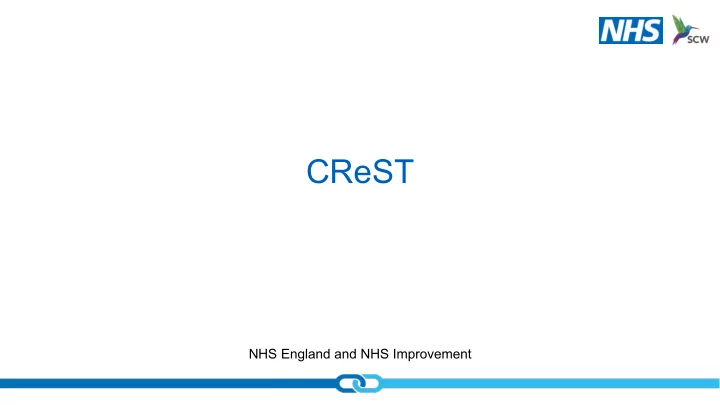

CReST NHS England and NHS Improvement
• CReST is a demand and capacity tool, developed for Children and Young People's Mental Health and was launched this year slightly earlier than planned, in response to the pandemic. • CReST has potential uses across the MHLDA sector and there are several Covid19 specific modelling scenarios explored on the CReST website. • CReST can be used to consider many questions such as: • How can I manage reduced capacity in my community team, because of absence/sickness? • How can I manage an influx of demand? • What is the optimum number of inpatient beds required for my demand? • Through inputting some basic information, CReST enables systems to review how available capacity will respond to the demand on the service. 2 2 | |
• CReST is based on the principles of queueing theory. • Queueing theory is the mathematical study of waiting lines, or queues. It uses a measure called ‘erlang' to describe utilisation of the available capacity in a queue. • Erlang is a 'family' of equations that are useful for different aspects of queue planning. • Erlang equations and approaches are often applied in relation to network traffic, for example call handling in call centres and telephone exchanges. • The equations can also be applied across many aspects of healthcare planning as well. 3 3 | |
Traditional erlang approach 4 4 | |
Erlang applied in a healthcare setting 5 5 | |
A brief example exploring… how to manage increased demand as a result of Covid19 NHS England and NHS Improvement
• In this hypothetical scenario, a small third sector counselling service (prior to Covid19) was accepting, on average, 250 referrals per year (approx. 4.8 accepted referrals per week) • Sessions were delivered at a number of locations, face to face, which involved significant travel alongside a small proportion of therapy being delivered digitally • Treatment was on average 6.3 sessions per person - this includes the service DNA rate ( more information on how to include your DNA rate in this figure is on the FAQ’s on the CReST website) • The service can currently deliver 35 appointments per week • They have been commissioned on the basis that they will see 85% of patients within 28 days 7 7 | |
Baseline scenario 8 8 | |
Increased demand scenario 9 9 | |
Increased demand scenario 10 10 | |
• The service lead then takes this information to discuss with the service director and together they consider the other impacts of Covid19 • It soon becomes evident that there are some real benefits in delivering more of the therapy digitally • There is positive feedback about people receiving their counselling sessions remotely • Therapists report having more time for clinical notes and for professional liaison relating to their cases as they are not losing as much time traveling between appointments • Most notably, the DNA rate reduced significantly , which means treatment is now on average 6 sessions per person (previously 6.3) 11 11 | |
Reduced DNA scenario 12 12 | |
Reduced DNA scenario 13 13 | |
Adjusted waiting time breach target 14 14 | |
Adjusted waiting time breach target 15 15 | |
The commissioners and service leads used the modelling to discuss and agree the optimum • number of appointments to commission The modelling helped the all the stakeholders to see the impact of any change to the waiting • time target and none wanted to alter it, as it was felt a key metric in ensuring those that need support can get access promptly Given the increased percentage of sessions being delivered digitally, and the subsequent • reduction in travel time, the service agreed that they can deliver 38 appointments per week (3 more than prior to Covid19) without having to increase staffing levels This final position will mean: • • An average waiting time of 11.7 days for 86% of cases • The appointments would be 94.1% utilised 16 16 | |
Final agreed position 17 17 | |
• As shown, to get started with CReST you only need 3 key figures (and these figures could be anticipated if you are modelling a new service) • The average number of accepted referrals for the service/unit in a period • The number of available appointments in the service in a period or the number of beds in the unit • The average number of appointments each accepted referral will receive during treatment, or the average length of stay for the unit • CReST is accessible to anyone in the UK working in a health or social care, and you can register and access the tool instantly on the website (http://dev.cypmh-model.nhs.uk/) • Today’s example and several other Covid19 specific modelling scenarios are explored on the website and there is a support team is on hand (cypmh.model@nhs.net) for any queries with registration / access and to support with modelling / analysis. 18 18 | |
Recommend
More recommend